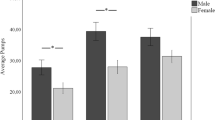Abstract
The primary index of reflection- impulsivity is Kagan's Matching Familiar Figures Test (MFF), which yields both a latency and an error score. To evaluate further the construct validity of these measures, both the latency and error scores of 9- and 15-year-old normal and “acting-out” behavior-disordered children were compared. Young behavior-disordered children were found to be more impulsive than the other groups on the MFF error measure. No differences occurred on the MFF latency measure. This result is consistent with previous findings with normal children in supporting the construct validity of the MFF error score and raising questions about the construct validity of the MFF latency score. Findings were inconsistent with Kagan's assertion that normal children become more reflective with age. The older behavior-disordered children were more reflective on the error measure than the younger behavior-disordered children and had equivalent error scores to both age groups of normals. This finding suggested a lag in the development of reflection in behavior-disordered children.
Similar content being viewed by others
References
Block, J., Block, J. H., & Harrington, D. M. Some misgivings about the Matching Familiar Figures Test as a measure of reflection-impulsivity.Developmental Psychology, 1974,10(5), 611–632.
Campbell, S. B., Douglas, V. I., & Morgenstern, G. Cognitive styles in hyperactive children and the effect of mithylphenidate.Journal of Child Psychology and Psychiatry, 1971,12, 55–67.
Cohen, N. J., Weiss, G., & Minde, K. Cognitive styles in adolescents previously diagnosed as hyperactive.Journal of Child Psychology and Psychiatry, 1972,13, 203–209.
Dunn, L. M.The Peabody Picture Vocabulary Test. Minnesota: American Guidance Service, 1965.
Eska, B., & Black, K. N. Conceptual tempo in young grade-school children.Child Development, 1971,42, 505–516.
Hallahan, D. P., Stainback, J., Ball, D. W., and Kauffman, J. M. Selective attention in cerebral palsied and normal children.Journal of Abnormal Child Psychology, 1973,1, 280–291.
Kagan, J. Impulsive and reflective children: Significance of conceptual tempo. In J. Drunboltz (Ed.),Learning and the educational process. Chicago: Rand McNally, 1965.
Kagan, J. Reflection-impulsivity and reading ability in primary grade children.Child Development, 1965,36, 609–628.
Kagan, J. Individual differences in the resolution of response uncertainty.Journal of Personality and Social Psychology, 1966,2, 154–160.
Kagan, J. Reflection-impulsivity: The generality and dynamics of conceptual tempo.Journal of Abnormal Psychology, 1966,71, 17–24.
Kagan, J., Moss, H. A., & Siegel, I. E. Psychological significance of style of conceptualization. In J. C. Wright & J. Kagan (Eds.), Basic cognitive processes in children.Monographs of the Society of Research in Child Development, 1963,28(2, Serial No. 86).
Kagan, J., Pearson, L., & Welch, L. The modificability of an impulsive tempo.Journal of Educational Psychology, 1966,57, 359–365.
Kagan, J., Rosman, B. L., Day, D., Albert, J., & Phillips, W. Information processing in the child: Significance of analytic and reflective attitudes.Psychological Monographs, 1964,78, (1, Whole No. 578).
Katz, J. M. Reflection-impulsivity and color-form sorting.Child Development, 1971,42, 745–754.
Lewis, M., Rausch, M., Goldberg, S., & Dodd, C. Error response time and IQ: Sex differences in cognitive style of preschool children.Perceptual and Motor Skills, 1968,26, 563–568.
Mussen, P. H., Conger, J. J., & Kagan, J.Child development and personality. New York: Harper & Row, 1974.
Nadeau, G. H.Cognitive style in preschool children: A factor analytic study. Unpublished doctoral dissertation, University of Minnesota, 1968.
Quay, L. C., & Weld, G. L.Selective attention to auditory and visual stimuli in normal and learning disabled children. Final Report to the Bureau of the Educationally Handicapped, 1977.
Ward, W. C. Reflection-impulsivity in kindergarten children.Child Development, 1968,39, 867–874.
Weiss, G., Minde, K., Werry, J. S., Douglas, V. I., & Nemeth, E. Studies on the hyperactive child: A five-year follow up.Archives of General Psychiatry, 1971,24, 409–414.
Author information
Authors and Affiliations
Additional information
The authors wish to thank Dr. Kenneth C. Molkner for his valuable assistance in obtaining subjects and for his kind support.
Rights and permissions
About this article
Cite this article
Brown, R.T., Quay, L.C. Reflection-impulsivity in normal and behavior-disordered children. J Abnorm Child Psychol 5, 457–462 (1977). https://doi.org/10.1007/BF00915093
Revised:
Issue Date:
DOI: https://doi.org/10.1007/BF00915093




